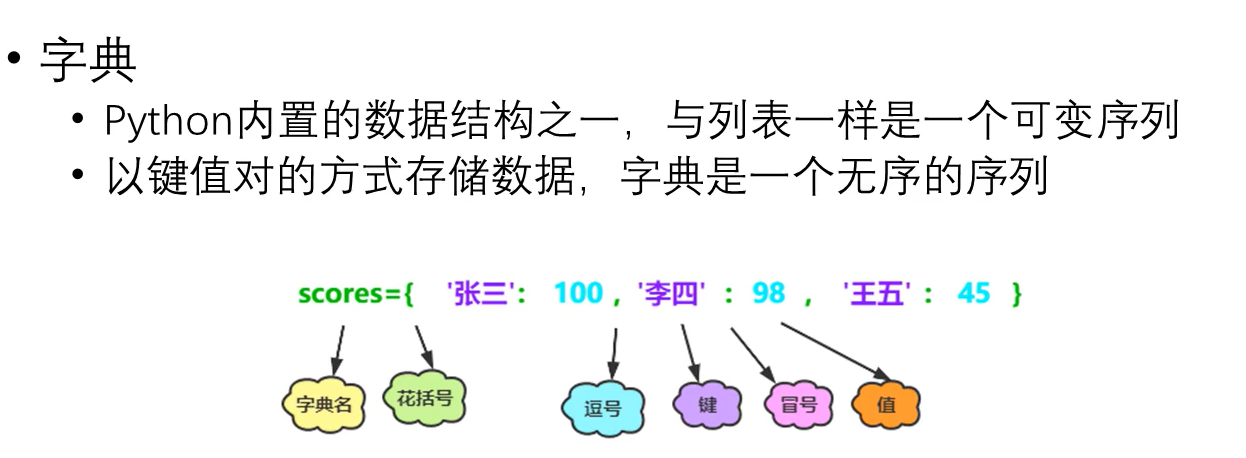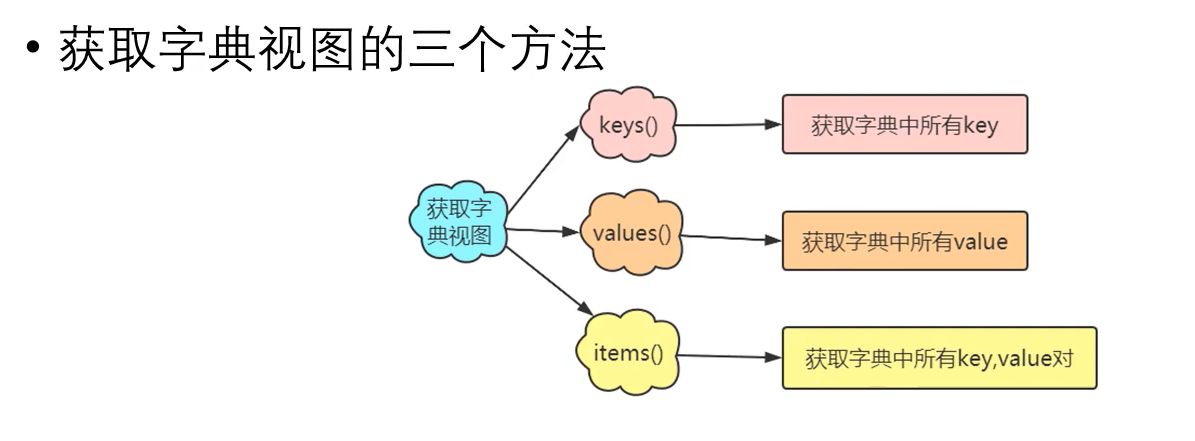字典
字典

字典的创建
1 # 2 # @author:浊浪 3 # @time: 2021/3/13 15:33 4 5 ''' 创建字典 ''' 6 # 两种方法 7 '''直接使用{}创建''' 8 score = {'zhangsan': 100, 'lisi': 80, 'wangwu': 60} 9 print(score) 10 print(type(score)) 11 12 '''使用内置函数dict创建 注意key不需要加单引号''' 13 student = dict(aaa=45, bbb="sdsds") 14 print(student) 15 16 '''创建空字典''' 17 d = {} 18 print(d)
字典元素的获取

1 # 2 # @author:浊浪 3 # @time: 2021/3/13 15:42 4 5 '''字典元素的获取的两种方法''' 6 score = {'zhangsan': 100, 'lisi': 80, 'wangwu': 60} 7 # '''第一种,使用[]''' 8 print(score['zhangsan']) 9 10 # print(score['sad']) #会报错 KeyError: 'sad' 11 12 13 # 第二种使用get()方法 14 print(score.get('zhangsan')) 15 print(score.get('sddsa')) #不会报错,返回none
字典的操作


1 # 2 # @author:浊浪 3 # @time: 2021/3/13 15:49 4 5 score = {'zhangsan': 100, 'lisi': 80, 'wangwu': 60} 6 print('zhangsan' in score) 7 print('zhangsan' not in score) 8 9 10 del score['zhangsan'] #删除一个指定的key-value对 11 # score.clear() #清空字典 12 print(score) 13 14 score['sad'] = 99 #新增一个元素 15 print(score) 16 17 score['sad'] = 98 #修改一个元素 18 print(score) 19 20 21 22 '''获取字典视图''' 23 # 获取所有的key值 24 keys = score.keys() 25 print(keys, ' ', type(keys)) 26 print(list(keys)) #把所有的keys组成一个列表 27 28 # 获取所有的value的值 29 value = score.values() 30 print(value, ' ', type(value)) 31 print(list(value)) #把所有的value组成一个列表 32 33 # 获取所有的key-value对 34 items = score.items() # 元组 35 print(items, ' ', type(items)) 36 print(list(items)) #把所有的items组成一个列表
字典的遍历
1 for i in score: 2 print(i, score[i], score.get(i))
字典的特点

字典生成式

1 # 2 # @author:浊浪 3 # @time: 2021/3/13 16:10 4 5 item = ['fruits', 'books', 'other'] 6 price = [90, 67, 93, 78, 89] 7 8 d = {item.upper():price for item, price in zip(item, price)} #value多的时候会截取前面的 9 print(d) 10 11 12 items = ['fruits', 'books', 'other', 'dfsd', 'fd'] 13 prices = [90, 67, 93, 79] 14 d1 = {items.upper():prices for items, prices in zip(items, prices)} #key多的时候会截取前面的 15 print(d1)